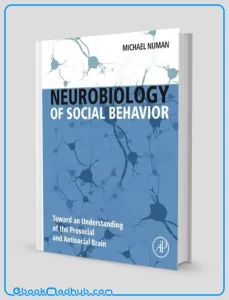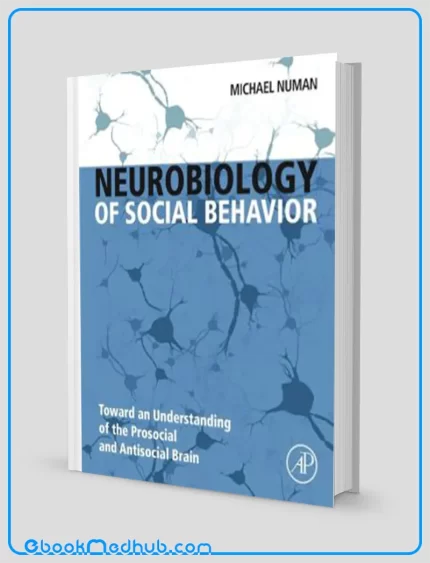Neurobiology of Social Behavior Toward an Understanding of the Prosocial and Antisocial Brain (ORIGINAL PDF from Publisher)
| Publisher |
Elsevier |
|---|---|
| Language |
English |
| Edition |
1st |
| Format |
Publisher PDF |
| ISBN 13 |
9780124160408 |
- Best Price Guaranteed
- Best Version Available
- Free Pre‑Purchase Consultation
- Immediate Access After Purchase
$47.60
Neurobiology of Social Behavior Toward an Understanding of the Prosocial and Antisocial Brain (ORIGINAL PDF from Publisher)
Social neuroscience is an area of study that is experiencing rapid growth and is characterized by its interdisciplinary nature. It is primarily concerned with unraveling the intricate mechanisms through which social behavior is governed by the brain, and reciprocally, how these behaviors shape the brain and biology.
However, the existing volumes in this field have some limitations: they either do not adopt a neurobiological perspective or focus solely on a specific type of behavior.
Consequently, there is a pressing need for a comprehensive reference that can draw conclusions across different behaviors, spanning the breadth of this field.
This forthcoming authored work aims to fill this gap and establish itself as the most exhaustive resource on the neurobiology of social behavior in the market.

Neurobiology of Social Behavior Toward an Understanding of the Prosocial and Antisocial Brain (ORIGINAL PDF from Publisher)
In order to achieve its goal, this volume will commence with an introduction that delves into the fundamental concepts of neural systems and genetics/epigenetics. This foundation will lay the groundwork for an in-depth examination of a diverse array of behaviors, encompassing aggression, sex and sexual differentiation, mating, parenting, social attachments, monogamy, empathy, cooperation, and altruism. Importantly, this work will not only present isolated findings on the neural underpinnings of social behavior, but will also integrate research across multiple levels of analysis.
This integration will encompass investigations at the molecular neurobiology level, as well as studies on neural circuits and systems, and even the utilization of fMRI imaging data to understand human social behavior.
The chapters within this comprehensive reference will encompass research on both normal and abnormal behaviors, ensuring a comprehensive understanding of the neural basis of social behavior.
By examining both ends of the spectrum, this work will provide a holistic perspective that allows for a deeper understanding of the complexities inherent in social behavior.
Furthermore, the developmental aspects of social behavior will not be overlooked, as they play a crucial role in shaping an individual’s social interactions and relationships throughout their lifespan.
One key feature that distinguishes this volume from others in the field is its ability to encompass a wide range of social behaviors within its neurobiological analysis. Unlike other works that solely focus on a single behavior, this comprehensive reference recognizes the interconnectedness of various social behaviors and aims to shed light on their shared neurobiological mechanisms.
This approach is crucial in understanding the complex interplay between different behaviors and the underlying neural processes that give rise to them.
In summary, this forthcoming authored work represents a significant contribution to the field of social neuroscience by providing a comprehensive reference on the neurobiology of social behavior.
By integrating research from different levels of analysis and covering both normal and abnormal behaviors, this volume offers a holistic understanding of the neural basis of social behavior.
Its coverage of a wide range of behaviors, from aggression to altruism, ensures that readers gain a comprehensive understanding of the diverse aspects of social behavior and the underlying neural mechanisms at play.

Neurobiology of Social Behavior Toward an Understanding of the Prosocial and Antisocial Brain (ORIGINAL PDF from Publisher)
Summary
“Neurobiology of Social Behavior Toward an Understanding of the Prosocial and Antisocial Brain” offers a comprehensive guide to conducting experiments in biochemical ecotoxicology for environmental conservation and protection.
This invaluable resource provides researchers and professionals with a detailed roadmap for carrying out experiments in the field of biochemical ecotoxicology, with a strong emphasis on understanding the social behavior of organisms in relation to their surrounding environment.
With the aim of promoting prosocial behavior and mitigating antisocial behavior, this book equips readers with a comprehensive understanding of the underlying neurobiology and molecular mechanisms involved in social interactions.
By employing state-of-the-art principles and cost-effective procedures, laboratories of all sizes and budgets can effectively contribute to the advancement of this field.
Each chapter of “Neurobiology of Social Behavior Toward an Understanding of the Prosocial and Antisocial Brain” begins by introducing the latest advancements in the field, ensuring that readers are up to date with the most cutting-edge research.
In addition, the book provides practical and affordable approaches to conducting experiments, making it accessible to a wide range of researchers and professionals. The necessary reagents are clearly outlined, enabling readers to replicate the experiments in their own laboratories. Moreover, the inclusion of case studies offers valuable insights into the practical application of the techniques discussed.
This ensures that readers not only understand the theory behind the experiments but also gain a practical understanding of how to execute them.
One of the highlights of this book is its coverage of high-throughput techniques such as quantitative polymerase chain reactions and enzyme-linked immunoassays.
These techniques allow researchers to analyze large quantities of data quickly and efficiently, making them particularly useful for studying social behavior in organisms.
Furthermore, “Neurobiology of Social Behavior Toward an Understanding of the Prosocial and Antisocial Brain” delves into cutting-edge approaches like gene expression profiling and lipidomic techniques. These advanced techniques provide researchers with a deeper understanding of the molecular mechanisms underlying social behavior, opening up new avenues for research and discovery.
With its focus on toxicity endpoint testing, “Neurobiology of Social Behavior Toward an Understanding of the Prosocial and Antisocial Brain” is an indispensable resource for professionals and researchers engaged in assessing and mitigating environmental toxicity.
By providing practical tools and methodologies, this book equips readers with the necessary resources to safeguard our ecosystems. The detailed instructions for result analysis ensure that researchers can accurately interpret their findings and draw meaningful conclusions.
Overall, this book is a valuable asset for anyone interested in understanding the neurobiology of social behavior and its implications for environmental conservation and protection.

Neurobiology of Social Behavior Toward an Understanding of the Prosocial and Antisocial Brain (ORIGINAL PDF from Publisher)
This website offers ( Neurobiology of Social Behavior Toward an Understanding of the Prosocial and Antisocial Brain (ORIGINAL PDF from Publisher) ) with just a few clicks.
The website strives to provide you with simple access to the medical field as well as readily available information that you can download.
You can download all of the books at a reasonable price and get the most recent scientific data in the world of medicine anytime you want at ebookmedhub.com.
Other Products :
Netters Obstetrics and Gynecology (Netter Clinical Science) (Original PDF from Publisher)
Membrane Structural Biology With Biochemical and Biophysical Foundations 2nd Edition (EPUB)
Principles of Biology 4th edition (Original PDF from Publisher)





Reviews
There are no reviews yet.